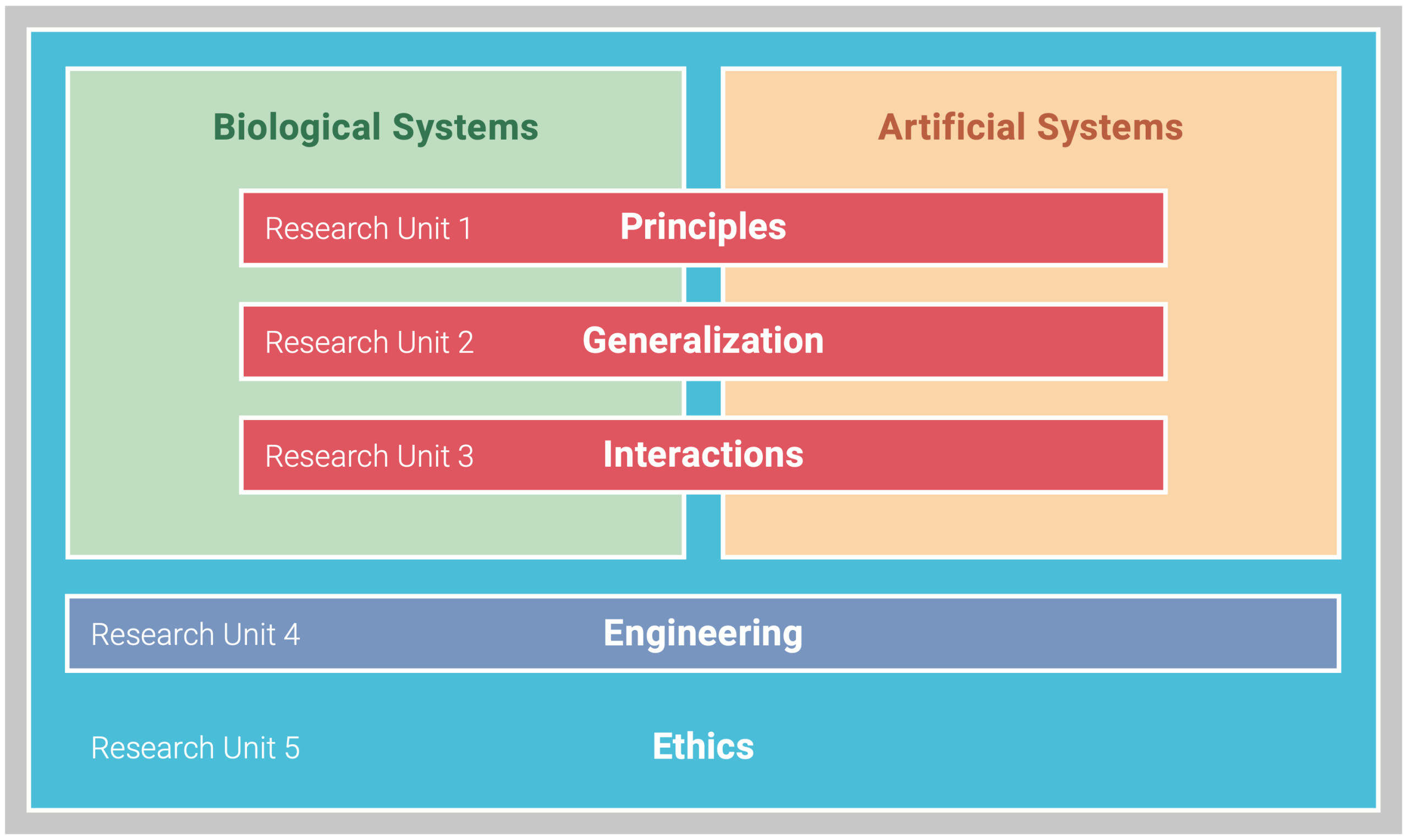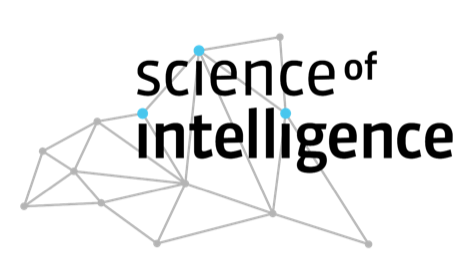3. Structure of the Research Program
Figure 19: SCIoI’s research program consists of five RUs. The first three units (red) — Research Unit 1 Principles, Research Unit 2 Generalization, and Research Unit 3 Interactions — investigate the principles of intelligence. These units bridge the two branches of SCIoI, one concerned with biological systems (green) and one concerned with artificial systems (orange). Research Unit 4 Engineering (blue-gray) develops engineering tools and practices to support intelligent systems research. Research Unit 5 Ethics (turquoise) frames, guides, and permeates the activities of the other four research units to ensure SCIoI progresses in an ethical manner.
The structure of SCIoI‘s research program is illustrated in Figure 19. The following sections will provide an outline of the interplay between the first three research units (the life cycle of a principle), the five research units themselves, and how research units 1, 2, and 3 connect the two branches of SCIoI, concerned with biological and artificial systems, respectively.
The life cycle of a principle of intelligence
The main scientific goal of SCIoI is to identify the principles of intelligence. These principles capture “a fundamental quality determining the nature of intelligence.” The first three research units (Principles, Generalization, and Interactions) are each concerned with a different stage in the life cycle of principles. For an overview of the principles we have identified so far and the empirical support for them.
The first stage of the life cycle (RU1 Principles) identifies the mechanistic principles of intelligence. Once a principle is identified, we study its generality in RU2 Generalization. To assess the generality, we characterize the situations in which a principle contributes to generating intelligent behavior. A situation is characterized by the species, the behavior, the ecological niche, specific tasks, and the level of abstractions at which a principle is applied. A principle must generalize along these dimensions to be considered as such.
By understanding the range of situations in which a principle is applicable, we learn how to associate principles with intelligent behaviors. This provides us with the ability to specify a conceptual, principle-based “blueprint” for an agent, given a particular intelligent target behavior. It will also allow us to predict under which circumstances an agent will perform intelligently. This ability indicates that we have acquired a comprehensive understanding of intelligence.
The third research unit in this life cycle, RU3 Interactions, discovers hypotheses for novel candidate principles. It does so by performing explorative system building research. When building a concrete system, we rely on the principles already identified. Successful system building based on the principles validates them and enables the discovery of gaps in our principles. Such a gap arises when certain aspects of intelligence cannot be synthesized successfully based on the principles we have identified so far. This gap leads to new candidate principle in RU1 Principles, completing the life cycle of principles of intelligence.
Here, we will use the terms principle and candidate principle interchangeably, acknowledging that all principles will remain candidate principles until independently confirmed by the wider scientific community. A list of current candidate principles has been provided, together with supporting empirical evidence.
Research Unit 1: Principles
This research unit is our factory for principles of intelligence.
Projects in investigate hypothesized candidate principles. Their goal is to gather empirical support for candidate principles and to show that they indeed capture “a fundamental quality determining the nature of” intelligence.
Research in RU1 Principles is hypothesis-driven. Projects begin by hypothesizing one or several candidate principles. To gather evidence in support of principles, projects develop suitable experimental paradigms, leverage behavioral observations, and devise a mechanistic formulation of the principle. This formulation is validated in behavioral experiments with biological/artificial species. If the mechanistic principle makes accurate predictions about behavior not previously observed, we consider this to be empirical support for a principle.
Research Unit 2: Generalization
This research unit examines a principle’s range of applicability across species and scales.
In contrast to principles in physics, which apply universally, we believe that principles of intelligence are valid only in ecological niches sharing certain properties. Each ecological niche exhibits unique regularities. Intelligent behavior in a niche necessitates the exploitation of those regularities, encoded in the principles relevant to the niche.
Projects in RU2 Generalization identify the range of situations in which the principle captures “a fundamental quality determining the nature of” intelligent behavior. In other words, projects test the generalization of the principle across the dimensions of the problem and solution space of intelligence. Projects may test generalization across species, tasks, cultures, developmental stages, or the levels of abstraction of the agent’s computational processes etc. In the context of RU2 Generalization, our comparative approach with its many different dimensions becomes particularly effective.
Research Unit 3: Interactions
This research unit produces hypotheses for new candidate principles.
RU3 Interactions differs from RU1 and RU2 in that it performs explorative research, in particular in the context of system building. While RU1 and RU2 are informed by the insights and results
obtained in SCIoI thus far, RU3 Interactions is designed to study the interactions of candidate principles during the generation of behavior and enable the discovery of new candidate principles. To enable this study, RU3 Interactions projects build real-world systems that produce intelligent behavior. Examples include robotic agents capable of escaping from an escape room or collaboratively solving a search task from RU3.
By building concrete systems, we test how the principles contribute to the desired behavior. During system building, we gain insight into the appropriate composition of principles, shed light on their compositional nature and explore the feasibility of leveraging principles in engineering practice. If the explorative system building leads to a gap between the target behavior and the behavior produced by the system, we can study this gap to hypothesize new principles or to identify aspects missing from our current characterization of intelligence.
Research Unit 4: Engineering
This research unit advances our abilities to build intelligent artificial systems.
As our understanding of intelligence progresses, we learn how to build, i.e., how to engineer, intelligent systems in the projects of RU4 Engineering. We expect and have already found substantial evidence that intelligent systems are built differently from the highly capable machines we have today (Li et al., 2024). Turning our insights into effective engineering tools and helpful engineering practice will improve our ability to engineer intelligent systems.
We will make the engineering practices available to the first three research units and to the wider scientific community. The ability to effectively engineer artificial systems will accelerate our ability to gain scientific insights from the A/S loop and the comparative approach.
Research Unit 5: Ethics
The prospect of synthesizing intelligent artificial agents raises important ethical and societal concerns. SCIoI is committed to ensuring that its scientific activities and technological outputs contribute to the well-being of humanity. RU5 Ethics provides a frame for the other four research units (Figure 19) to ensure that we uphold this commitment.
Our activities within RU5 Ethics fall into three categories. First, we support, evaluate, and assess prospective research activities at SCIoI. This is done, in part, by our ethics process and we will continue to develop and research our framework and make it available for other centers working on intelligence research. Second, we will continue to develop best practices for conducting basic research on intelligence, especially ensure that ethical considerations already guide the research process at the earliest stages. Finally, we will conduct empirically grounded ethics research. SCIoI provides our ethics team with a unique environment where they can interact with researchers conducting cutting edge intelligence research. This ethics research then also feeds back into our development of best practices, and it can also contribute to the empirical intelligence research done at SCIoI.
Branches for biological and artificial systems
The first three research units span the realms of both biological and artificial intelligent systems. Below, we explain what this means in the context of each unit.
RU1: The study of a particular candidate principle can be performed in biological and artificial systems. Both systems will have vastly different properties, as was explained in the context of the A/S loop. These different properties, taken together with the comparative approach to research, offer rich opportunities to learn about the underlying principles from comparisons made between different artificial and biological species.
RU2: Systems within the two branches currently only share few commonalities. Therefore, we expect to gain complementary information from studying the generalization of principles in both branches based on the comparative approach.
RU3: Differs from the previous two research units: The two branches have dedicated roles. The biological branch conducts experiments with biological systems to characterize behavior and to learn about how it might be realized. The other branch then uses these insights to reproduce them in a synthetic system.





